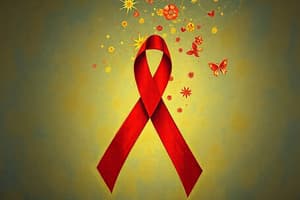Podcast
Questions and Answers
Why is virological testing necessary for babies under 18 months old?
Why is virological testing necessary for babies under 18 months old?
- To perform rapid diagnostic tests
- To identify HIV infection accurately (correct)
- To prevent accidental needlestick injuries
- To control and eventually eradicate HIV
What can result in HIV transmission among health workers?
What can result in HIV transmission among health workers?
- Having voluntary medical male circumcision
- Accidental needlestick injuries (correct)
- Using male or female condoms improperly
- Getting tested for HIV and STIs frequently
Which prevention strategy is NOT recommended to reduce HIV transmission?
Which prevention strategy is NOT recommended to reduce HIV transmission?
- Using condoms during sex
- Voluntary medical male circumcision
- Getting tested for HIV and STIs
- Sharing injection equipment (correct)
What enables same-day results for appropriate linkage with treatment and care for HIV infection?
What enables same-day results for appropriate linkage with treatment and care for HIV infection?
What is crucial for developing effective prevention strategies against HIV?
What is crucial for developing effective prevention strategies against HIV?
Why is understanding various modes of HIV transmission important?
Why is understanding various modes of HIV transmission important?
What is the primary mode of HIV transmission through sexual contact?
What is the primary mode of HIV transmission through sexual contact?
How does condom usage impact the chances of HIV transmission during sex?
How does condom usage impact the chances of HIV transmission during sex?
Which is NOT a route of HIV transmission associated with sharing needles and injection equipment?
Which is NOT a route of HIV transmission associated with sharing needles and injection equipment?
When does mother-to-child transmission of HIV occur?
When does mother-to-child transmission of HIV occur?
What can lead to a higher risk of HIV transmission during sexual contact?
What can lead to a higher risk of HIV transmission during sexual contact?
What is the most common method of HIV transmission among people who inject drugs?
What is the most common method of HIV transmission among people who inject drugs?
Flashcards are hidden until you start studying
Study Notes
HIV Transmission
HIV, or human immunodeficiency virus, is a virus that attacks the body's immune system. It can lead to acquired immunodeficiency syndrome (AIDS) if not treated. HIV transmission occurs primarily through four main methods: sexual contact, sharing needles or other injection equipment, mother-to-child transmission during pregnancy, childbirth, or breastfeeding, and accidental needlestick injuries.
Sexual Contact
HIV is primarily transmitted through sexual contact, most commonly via anal intercourse. The risk of HIV transmission depends on several factors such as the type of epithelium in the genital tract, the presence of sexually transmitted infections (STIs), and the type of intercourse. For instance, the risk of infection for receptive anal intercourse is higher compared to vaginal intercourse due to differences in epithelial layers. Condom usage significantly reduces the chance of HIV transmission during sex.
Sharing Needles and Other Injection Equipment
Sharing contaminated needles, syringes, drug solutions, cookers, and other injecting equipment is another major route of HIV transmission, especially among people who inject drugs. This mode of transmission can also spread HIV to others via infected blood products or from accidental sharps injuries.
Mother-to-Child Transmission
Mother-to-child transmission of HIV occurs during pregnancy, childbirth, or breastfeeding. Rapid diagnostic tests for HIV infection cannot identify HIV in babies under 18 months old, so virological testing is necessary at birth. New technologies have been developed to perform this test at the point of care, enabling same-day results for appropriate linkage with treatment and care.
Accidental Needlestick Injuries
Accidental needlestick injuries can also result in HIV transmission, especially among health workers who are exposed to blood or other bodily fluids during medical procedures that involve cutting or piercing without proper sterilization.
Prevention Strategies
Prevention strategies include using male or female condoms during sex, getting tested for HIV and STIs, having voluntary medical male circumcision, and being aware of potential risks associated with drug use and sharing injection equipment.
In summary, understanding the various modes and factors influencing HIV transmission is crucial for developing effective prevention strategies to control and eventually eradicate this disease.
Studying That Suits You
Use AI to generate personalized quizzes and flashcards to suit your learning preferences.




